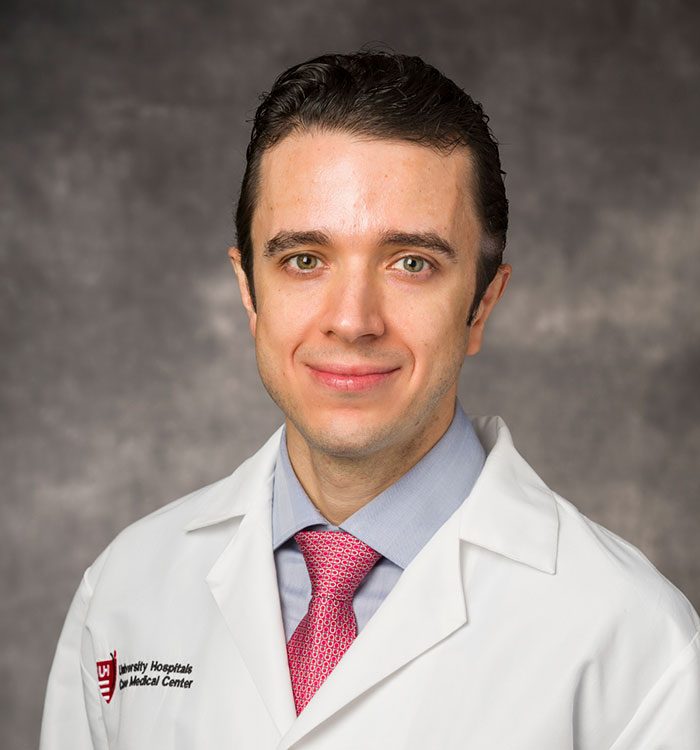Guilherme Attizzani, MD, Named National PI for RESTORE Study of Repeat TAVR in Patients with Failed Transcatheter Heart Valves
October 13, 2024
Innovations in Cardiovascular Medicine & Surgery | October 2024
Interventional cardiologist Guilherme Attizzani, MD, Director of the Valve and Structural Heart Disease Center and the Alexander and Marianna McAfee Chair in Innovative Cardiac Interventions at University Hospitals Harrington Heart & Vascular Institute, has been selected to serve as the national principal investigator (PI) of RESTORE, a novel multicenter trial investigating repeat transcatheter aortic valve replacement (TAVR) to remedy a failing transcatheter device previously implanted — a procedure known as TAV-in-TAV. Basel Ramlawi, MD, System Chief of Cardiac Surgery at Main Line Health in Philadelphia, Pennsylvania, will be the co-principal investigator.
 Guilherme Attizzani, MD
Guilherme Attizzani, MD“This is the very first investigational study that will enhance our understanding of how to redo TAVR,” says Dr. Attizzani. “Our goal is to develop a comprehensive knowledge of the nuances involved in placing a new transcatheter valve inside a previously placed device. There are a lot of challenges with these procedures, starting from the complex planning and appropriate sizing, and finishing with perfect execution to avoid complications such as occlusion of coronary flow.”
Medtronic, an industry leader in heart valve devices, is sponsoring the trial. The RESTORE leadership team and screening committee are meeting weekly to finalize protocols, with researchers anticipating patient enrollment to begin in early 2025.
TAVR Moves into its Second Generation
The first TAVR device was approved for U.S. use in 2011. The less invasive alternative to surgical aortic valve replacement has been particularly impactful for patients unsuitable for surgical intervention due to high-risk profiles and comorbidities.
University Hospitals Harrington Heart & Vascular Institute was one of the first in the country to perform the minimally invasive procedure under conscious sedation to treat severe aortic stenosis. Over the past decade, UH Harrington Heart & Vascular Institute experts have become internationally recognized for their pioneering TAVR techniques. In addition to achieving high clinical volumes, this team of providers have trained hundreds of peers around the world virtually and in person.
More than a quarter of a million patients have received valve replacement via TAVR in the United States. While patient registries and long-term studies demonstrate low TAVR failure rates, device complications may include deterioration, leaks, migration, infection or thrombosis. As the population ages, an increasing number of previously placed valves are reaching the end of their functionality. Even a small percentage of failures results in a growing demand for follow-up treatment.
“Many cardiac centers have placed a second valve in a failing TAVR,” Dr. Attizzani says. “Although there is isolated data and operator experience, we have never had a formal study to address this scenario comprehensively. As we gather data, our goals include identifying the ideal candidate for replacement TAVR, determining optimal procedural methods and delivering crucial information to our peers in the field.”
Questions Dr. Attizzani and his research colleagues are considering include:
- What is the ideal way to position one valve inside another?
- What are the best techniques to prevent coronary occlusion?
- How can hemodynamic performance be optimized?
- What are the nuances of the different combinations of valves?
- Balloon-expandable valves
- Self-expandable valves
- Mechanically expanded valves
“Looking at the valves available in the market, any combination of devices is possible for repeat TAVR,” Dr. Attizzani says. “For example, if you have a failing self-expandable valve, do you replace it with another self-expandable or balloon-expandable valve? It is important to understand and document how these devices interact so that we can meaningfully contribute to the scientific literature and deliver excellent outcomes to patients.”
For more information, contact Dr. Attizzani at Guilherme.Attizzani@UHhospitals.org.
Contributing Expert:
Guilherme Attizzani, MD
Director, Valve and Structural Heart Disease Center
Alexander and Marianna McAfee Chair in Innovative Cardiac Interventions
University Hospitals Harrington Heart & Vascular Institute
Professor
Case Western Reserve University School of Medicine


